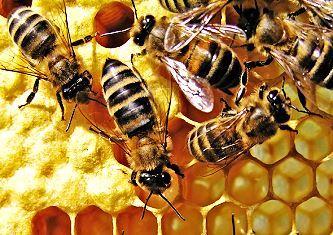Honey Bee's Propolis a natural cure for cancer cells and viruses
Honey Bee's Propolis a natural cure for cancer cells and viruses
Bees have always played an important role in the healing human body by its natural contents and micronutrients for humanity around the world. Wild Honey has been valued since ancient times for its sweetness and prized at the same time for its amazing medicinal anti-bacterial properties. As far back as the times of the ancient Sanatana (Vedic), Greeks and Egyptians culture there is evidence to show that honey was used for its antimicrobial properties and even today in our rural India honey is used for the cure of multiple deficiencies as well as a better cure for cough and other ailments. It is making a strong comeback in the area of wound healing, where it seems to be able to treat even some of the most difficult wounds, such as diabetic foot ulcers, sores, throat and even intestinal infections. Honey is not the only bee product that modern science is discovering uses for. One such product from bee's Kingdom is propolis, whose compound seems to be able to help fight the never-ending war being waged on cancer.
What is Propolis?
Honey is made from the pollen of flowering plants and used by bees as a source of nutrition. Propolis, on the other hand, is more of a tool. It is a thick, caulk-like substance which bees produce to help them repair holes in their hives. Propolis also is known as Propolis balsam, propolis resin, propolis wax, bee glue, hive dross. This looks like glue and with help of this bees stick and repair their hives. The quality varies from season to season or area to area on the other hand. These hives are intricate systems of living quarters, food storage quarters and n urseries for young larvae and thus need constant maintenance. Bees are not the only ones which have found propolis to be so useful. Like honey, it has been used since ancient times for its array of beneficial properties since it has been proven to be an Antioxidant, Anti-inflammatory, Anti-microbial Disinfectant. We do know that propolis’ antibiotic properties come from a substance called galangin, and that it boosts immunity by increasing phagocyte activity (phagocytes are body’s “warriors” against germs). We also know that its anti-inflammatory properties derive from its ability to prohibit prostaglandins. Components called phytotonizides play a role in propolis’ ability to enhance the immune system, as they appear to stimulate phagocytosis. The anti-carcinogenic properties of the propolis can now be added to the list of most curing natural product on earth.
urseries for young larvae and thus need constant maintenance. Bees are not the only ones which have found propolis to be so useful. Like honey, it has been used since ancient times for its array of beneficial properties since it has been proven to be an Antioxidant, Anti-inflammatory, Anti-microbial Disinfectant. We do know that propolis’ antibiotic properties come from a substance called galangin, and that it boosts immunity by increasing phagocyte activity (phagocytes are body’s “warriors” against germs). We also know that its anti-inflammatory properties derive from its ability to prohibit prostaglandins. Components called phytotonizides play a role in propolis’ ability to enhance the immune system, as they appear to stimulate phagocytosis. The anti-carcinogenic properties of the propolis can now be added to the list of most curing natural product on earth.
Propolis and Cancer
Previously propolis or bees glue was used to treat sores, intestinal infections, genital herpes etc. by the tribal people who used it as their folk medicine. Interest in propolis in the area of oncology has been initiated by a study on bees and their processing of honey hives. In this research study, a particular compound was isolated from propolis called caffeic acid phenethyl ester (or CAPE). Research and development analysis on propolis found that it has a bioactive compound that can be used to treat prostate cancer cells found in men. This was an in vivo study, meaning that it took place in a laboratory with cancer cells raised in a test tube. In the presence of CAPE, it was found that the cancer cells rate of growth was slowed by a whopping 50% to 60%. The phenomenon working to kill cancer cell by propolis was not killing the cancer cells directly, but by interfering with bio iterfering signals on ATP which control the rate at which these cells are reproduced in the cancerous tissues of the body by providing them energy mechanism. Though, CAPE does have cytotoxic properties, meaning that it can, in fact, kill off cancer cells directlly but it may not be harmful to human body as chemotherapy and other anti- carcinomic treatment does. It will have good results to control on prostate cancer cells, colon cancer cells and on carcinomic growth anywhere in the human body.
Other recorded uses of Propolis
- Propolis is used for canker sores and infections caused by bacteria (including tuberculosis), by viruses (including flu, H1N1 "swine" flu, and the common cold), by fungus, and by single-celled organisms called protozoans.
- Propolis is also used for cancer of the nose and throat;
- For boosting the immune system; and
- For treating gastrointestinal (GI) problems including Helicobacter pylori infection in peptic ulcer disease.
- Propolis is also used as an antioxidant and anti-inflammatory agent.
- It is also commonly used to lower blood pressure and stimulate system of human body organs.
Source: Dr Vikram Sharma, Email-drvsharma99@gmail.com, Mob-+91-9417138927
Last Modified : 6/23/2024
